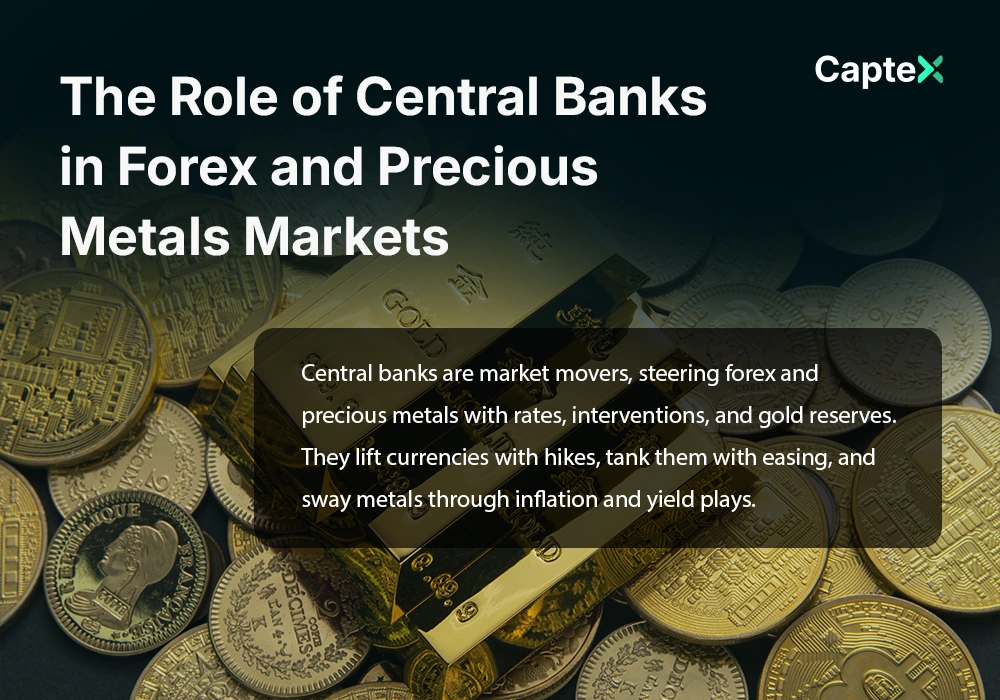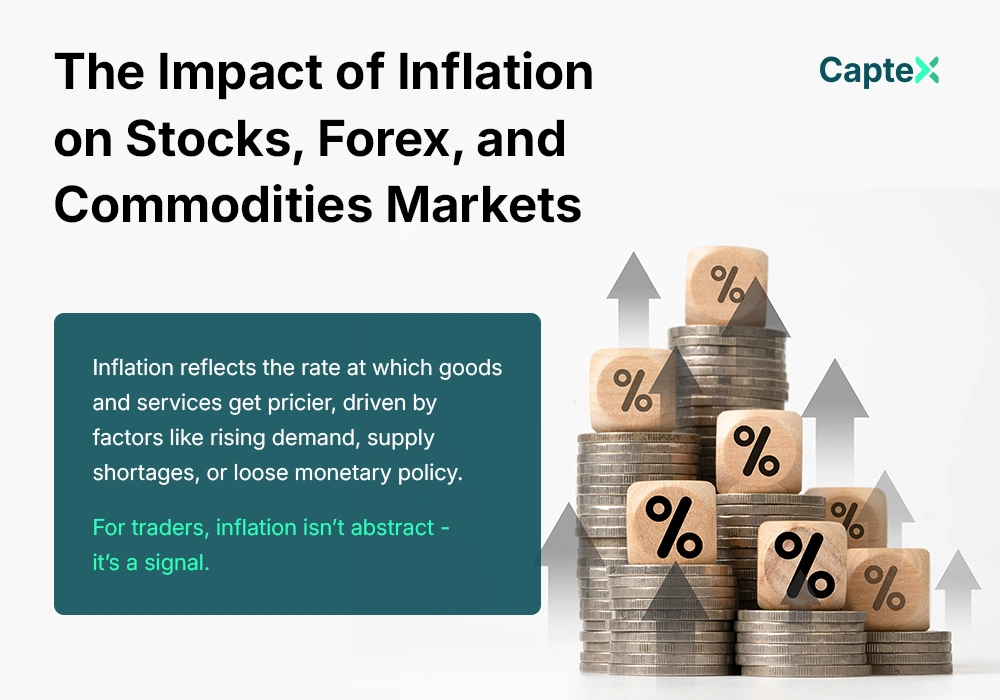Central banks wield immense influence over global financial markets, acting as architects of monetary policy and guardians of economic stability. In forex and precious metals markets, their decisions—on interest rates, currency interventions, and gold reserves—ripple through prices and trading opportunities. Understanding their role is key to navigating these interconnected arenas. Let’s unpack how central banks shape forex and precious metals and how traders can respond.

Central Banks and Their Core Functions
Central banks, like the Federal Reserve, European Central Bank (ECB), or Bank of Japan (BoJ), manage a nation’s money supply, interest rates, and currency value. Their goals? Control inflation, spur growth, and stabilize exchange rates. In forex, they directly impact currency pairs by tweaking rates or intervening in markets. In precious metals, their policies influence gold and silver as safe-haven assets tied to economic confidence.
These institutions don’t trade for profit—they prioritize policy. Yet their moves—planned or surprise—trigger volatility that traders can exploit. A rate hike or dovish statement isn’t just news; it’s a signal to act. Knowing their mandates helps you anticipate the domino effect on currencies and metals.
Interest Rates and Forex Market Movements
Interest rates are a central bank’s loudest megaphone in forex. When a bank raises rates, its currency often strengthens—higher yields attract foreign capital, boosting demand. Take the U.S. Federal Reserve: a rate hike lifts the U.S. dollar (USD), pushing pairs like EUR/USD lower. Conversely, a rate cut weakens the currency as investors seek better returns elsewhere.
The carry trade thrives here—borrow a low-rate currency (like Japan’s yen) to buy a high-rate one (like Australia’s dollar). Rate differentials drive pairs like AUD/JPY. Watch central bank meetings and forward guidance—hawkish tones (favoring hikes) signal strength, dovish ones (cuts or easing) hint at weakness. Timing matters; markets often price in expectations early.
Currency Interventions and Exchange Rate Control
Sometimes central banks step in directly, buying or selling their currency to manage its value. The Bank of Japan has a history of selling yen to curb excessive strength, protecting its export economy—USD/JPY spikes as a result. Switzerland’s central bank once pegged the franc (CHF) to the euro, buying euros to cap CHF gains, impacting EUR/CHF.
These interventions jolt forex markets, creating short-term trades. A sudden yen sell-off might offer a quick USD/JPY buy. But they’re rare and risky—banks signal intent to avoid surprises, and effects fade if fundamentals don’t align. Monitor official statements and forex volume spikes for clues.
Factors triggering interventions:
- Sharp currency appreciation hurting exports.
- Speculative attacks destabilizing markets.
- Trade imbalances threatening growth.
- Inflation pressures needing quick fixes.
- Coordinated moves with other banks.
Central Banks as Gold Holders and Influencers
Central banks hold vast gold reserves—over 35,000 tons globally—making them heavyweight players in precious metals. Gold isn’t just a relic; it’s a buffer against currency crises and a confidence signal. When banks buy gold—like Russia or China diversifying from USD—it can nudge prices up, reflecting distrust in fiat money. Sales, though rare, might depress prices.
Their influence goes beyond physical trades. Policy shifts—like the Fed tightening—dent gold’s appeal as yields rise, since gold pays no interest. A dovish ECB, easing rates, might lift gold as euro weakens. XAU/USD (gold in USD) tracks these moves—watch reserve data and policy speeches for direction.

Monetary Policy and Precious Metals Prices
Monetary policy shapes precious metals indirectly through inflation and currency strength. Loose policy—low rates, quantitative easing—floods markets with money, stoking inflation fears. Gold and silver shine as hedges, often rallying during easing cycles. Tight policy—rate hikes, tapering—strengthens currencies and cools metals, as real yields outpace non-yielding assets.
Take 2020: global easing amid a crisis sent gold to record highs. Contrast with a hawkish Fed pivot—XAU/USD often dips as USD climbs. Silver, with its industrial tilt, feels this less but still tracks gold’s sentiment. Economic data—like CPI or payrolls—hints at policy shifts, giving traders a lead.
Impact of Quantitative Easing on Forex and Metals
Quantitative easing (QE)—central banks buying bonds to inject cash—weakens currencies and boosts metals. When the Fed launched QE, USD softened, lifting EUR/USD and gold in tandem. More money chasing goods devalues fiat, making precious metals a refuge. Silver often outpaces gold here, given its volatility.
QE’s forex effect hinges on scale and surprise. A bigger-than-expected program tanks the currency faster—think USD/JPY dropping as yen gains. Traders can ride these waves: short the easing currency, go long metals. But when QE ends or tapers, the reverse kicks in—USD rebounds, metals sag. Watch bond yields and bank balance sheets for timing.
Central bank QE signals:
- Large-scale bond purchases announced.
- Dovish rhetoric hinting at prolonged easing.
- Economic slowdown prompting stimulus.
- Inflation targets driving policy shifts.
- Market reactions amplifying initial moves.
Forex Volatility from Central Bank Announcements
Central bank decisions—rate changes, QE updates, or forward guidance—spark forex volatility. A surprise Fed cut might send USD/CAD tumbling as CAD gains. Scheduled events, like ECB meetings, see pairs like EUR/USD whip around as traders digest outcomes. Even “no change” can move markets if it defies bets.
Prep with economic calendars—mark key dates like Fed minutes or BoJ reviews. Pre-announcement ranges tighten, then explode post-news. Scalpers thrive here, but swing traders can wait for trends to settle. Use stops—volatility cuts both ways—and avoid over-leveraging ahead of these fireworks.
Trading Strategies Around Central Bank Actions
Leverage central bank moves with tailored strategies. For forex, trade the breakout: buy EUR/USD on a dovish Fed hint, using Bollinger Bands to spot the surge. In metals, fade tightening—short XAU/USD if rates rise, confirmed by RSI overbought signals. Carry trades shine long-term—hold AUD/JPY during a BoJ easing cycle.
Blend fundamentals (policy outlook) with technicals (support levels) for precision. Pre-position before big announcements if confident, or wait for post-news dust to settle. Backtest against past rate shifts—say, Fed hikes versus USD strength—to refine your edge. Risk management is non-negotiable; these events can pivot fast.
Limitations of Central Bank Influence
Central banks aren’t omnipotent. Markets can defy them—USD might shrug off a hike if growth stalls. Interventions fail if speculators overwhelm reserves, as seen in past currency crises. Precious metals react to broader forces too—industrial demand for silver or geopolitical shocks can outweigh policy.
External noise—like trade wars or oil spikes—muddies their impact. Forward guidance can backfire if credibility wanes. Traders must weigh bank actions against global context, using data like PMI or commodity prices to filter signals. It’s a piece of the puzzle, not the whole picture.
Bottom Line
Central banks are market movers, steering forex and precious metals with rates, interventions, and gold reserves. They lift currencies with hikes, tank them with easing, and sway metals through inflation and yield plays. Traders who decode their signals—via announcements, QE shifts, or reserve moves—can ride the waves or hedge the risks. But their power has limits; context is king. Pair this insight with discipline and technicals, and you’ll turn central bank clout into your trading advantage.





